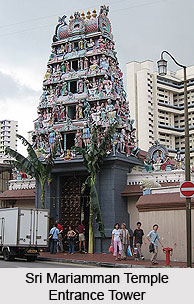 Nilakkottai is located in Dindigul district in the Indian state of Tamil Nadu. It is a panchayat town situated at 10.17°N 77.87°E. The town has an average elevation of 320 metres. The enchanting Sirumalai Hills located almost 10 km from Nilakkottai serves as an important tourist spot here.
Nilakkottai is located in Dindigul district in the Indian state of Tamil Nadu. It is a panchayat town situated at 10.17°N 77.87°E. The town has an average elevation of 320 metres. The enchanting Sirumalai Hills located almost 10 km from Nilakkottai serves as an important tourist spot here.
Demography of Nilakkottai
According to the Indian census report of 2001 Nilakkottai had a population of 19,630. The males constitute 50% and the females constitute 50% of the population. The town has an average literacy rate of 71%. It is higher than the national average of 59.5%. The male literacy rate is 76%, and female literacy rate is 66%. 12% of the population is under 6 years of age in Nilakkottai.
Festivals in Nilakkottai
Nilakkottai is an important pilgrimage centre visited by many devotees. Mari Amman Kovil is an important Hindu Temple here. Devotees visit the temple mainly on Fridays and on other special pooja days. One of the most important festivals celebrated here is the Thiruvizha. The festival is organised for a week and celebrated with much enthusiasm and gaiety. People along with their families from around 30 villages visit the town during the festival. The festival begins with the hoisting of the flag known as Kodi Etram. The event takes place in the centre of the temple. Every day Utsava Murthis are beautifully decked and taken out for procession, once during the morning hours and once during the evening hours. Different vahanas or vehicles are used for the procession. On the second day of the festival devotees bear hot pots in their hands and visit the temple. There they offer prayer at the feet of the deity. They perform the Karumbu Thotil in which two people hold two ends of a sugar cane. A cloth is tied in the centre. A kid is positioned in the center and with it they reach to the temple. Next, on the third day devotes bear a pot of milk to the temple and pour it on the goddess. This ritual is known as Pal Kudam. On the fourth day the Unchal Seva ritual is observed. The deities are beautifully decorated and are placed on a golden swing. All the ladies sing hymns in praise of the deities. On the final day of the festival known as Poo Palaku the deities are taken out for procession on a pallaku decorated with flowers. The ladies carry the Mulaipari. In the year 2012 Mari Amman Kovil celebrated its 100 years being established in 1912.
 Educational Institutions of Nilakkottai
Educational Institutions of Nilakkottai
There are many schools and colleges located at Nilakkottai established to fulfil the educational needs of the children residing here. Some of the schools here are Sourastra School, H.N.U.P.R. Matric School, H.N.U.P.R. Girls. Hr. Sec. School, Govt. Boys High Sec School, K.C.M. Matric. School, K.C.M. Matric School, Nadar Middle School, Sri Lagu Vel Maya Primary School and others. Some of the colleges established here are Government Arts College for Women and Navalar ITI College.
Tourist Places in Nilakkottai
Nilakkottai serves as a significant tourist spot. The hills of the place, dotted with vineyards suffice the hunger of nature admirers and tourists. Flowers are also cultivated aplenty in Nilakkottai. Marudanadhi River and Vaigai River flow by in the adjacent region. In
The adjoining areas many important places have also flourished. Silukkuvarpatti, Ammayanaickanur, Pallapatti, Batlagundu, Pattiveeranpatti, Oruthattu and Sevugampatti are some of the worth mentionable places to tour. An admired hill station is located at Kodaikanal. Nilakkottai lies 13 km southwest of Ambaturai, 13 km northwest to Vadippatti and 8 km north of Kullichettippatti.
The Anjaneyar Temple has become a primary attraction of Nilakkottai. Nilakkottai Agro Industrial Complex, lying at Palapatti, is the key institution here. The famous tourist destination Kadavakurichi Reserve Forest is located 4 km southwest of the town.
Nilakkottai is well connected with all modes of transport. The nearest airport at Madurai lies 37 kms away. Kodaikanal Road Railway Station is in the vicinity. From Nilakottai one can reach Dindigul. NH 7 also runs through Nilakottai.



















